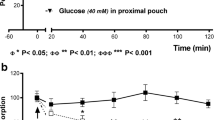Abstract
Serum gastric inhibitory polypeptide was measured in dogs prepared with Heidenhain pouches and Mann-Bollman fistulae following the intraduodenal (ID) infusion of isotonic saline, 20% glucose, or 20% mannitol. Following ID 20% glucose, serum GIP concentrations rose significantly (P<0.05) between 30 and 120 min and there was a significant inhibition (P<0.05) of acid secretion in the Heidenhain pouches between 15 and 75 min. A good correlation (r=0.925) was found between the rise in serum GIP and the inhibition of acid secretion. Although neither ID isotonic saline nor 20% mannitol stimulated GIP release, the latter produced a significant (P<0.05) inhibition of acid secretion between 60 and 105 min. We conclude: (1) the inhibitory effect of acid secretion following ID glucose is mediated in part by the release of endogenous GIP; (2) glucose and mannitol probably inhibit gastric acid secretion by different mechanisms.
Similar content being viewed by others
References
Day JJ, Komarov SA: Glucose and gastric secretion. Am J Dig Dis 2:527–531, 1939
Konturek S, Grossman MI: Effect of perfusion of intestinal loops with acid, fat, or dextrose on gastric secretion. Gastroenterology 49:481–489, 1965
Shay H, Gershon-Cohen J, Fels SS, Siplet H: Concerning the influence of glucose on the response of the human stomach to test meals. Am J Dig Dis 9:363–367, 1942
Sircus W: Studies on the mechanism in the duodenum inhibiting gastric secretion. Q J Exp Physiol 43:114–133, 1958
Pederson RA, Brown JC: Inhibition of histamine, pentagastrin and insulin-stimulated canine gastric secretion by pure “gastric inhibitory polypeptide”. Gastroenterology 62:393–399, 1972
Villar HV, Fender HR, Rayford PL, Bloom SR, Ramus NI, Thompson JC: Suppression of gastrin release and gastric secretion by gastric inhibitory polypeptide (GIP) and vasoactive intestinal polypeptide (VIP). Ann Surg 184:97–102, 1976
Polak JM, Bloom SR, Kuzio M, Brown JC, Pearce AGE: Cellular localization of gastric inhibitory polypeptide in the duodenum and jejunum. Gut 14:284–288, 1973
O'Dorisio TM, Cataland S, Stevenson M, Mazzaferri EL: Gastric inhibitory polypeptide (GIP): Intestinal distribution and stimulation by amino acids and medium chain triglycerides. Am J Dig Dis 16:865–872, 1976
Cataland S, Crockett SE, Brown JC, Mazzaferri EL: Gastric inhibitory polypeptide (GIP): Stimulation by oral glucose in man. J Clin Endocrinol Metab 39:223–228, 1974
Sirinek KR, Crockett SE, Mazzaferri EL, Cataland S, Thomford NR: Release of gastric inhibitory polypeptide: Comparison of glucose and fat as stimuli. Surg Forum 25:361–363, 1974
Brown JC, Dryburgh JR, Ross SA, Dupré J: Identification and actions of gastric inhibitory polypeptide. Rec Prog Horm Res 31:491–497, 1975
Martin EW,Jr, Sirinek KR, Spaeth JT, O'Dorisio TM, Cataland S, Thomford NR: The peak gastric acid response of the Heidenhain pouch to pentagastrin. A new concept. Rev Surg 34:293–294, 1977
Hirschowitz BI, Sachs G: Pentagastrin in the gastric fistula dog. Gastroenterology 56:456–467, 1969
Wheeler MH, Prescott RJ, Prescott HPM: Antral and duodenal acidification: Effect on pentagastrin-stimulated acid secretion in the dog. Am J Surg 128:331–335, 1974
Nakajima S, Magee DF: Inhibition of Heidenhain pouch pepsin secretion by commercial cholecystokinin and duodenal fat in dogs. Ann Surg 180:243–246, 1974
Kuzio M, Dryburgh JR, Malloy KM, Brown JC: Radioimmunoassay for gastric inhibitory polypeptide. Gastroenterology 66:357–364, 1974
Thomas FB, Mazzaferri EL, Crockett SE, Mekhjian HS, Grumer HD, Cataland S: Stimulation of secretion of gastric inhibitory polypeptide and insulin by intraduodenal amino acid perfusion. Gastroenterology 70:523–527, 1976
Colton T: Statistics in Medicine, 1st ed. Boston, Little, Brown, 1974
Anderson S, Nilsson G, Uvans B: Effect of acid in proximal and distal duodenal pouches on gastric secretory responses to gastrin and histamine. Acta Physiol Scand 71:368–378, 1967
Boden G, Essa N, Owen OE, Reichle FA: Effect of intraduodenal administration of HCI and glucose on circulating immunoreactive secretin and insulin concentrations. J Clin Invest 53:1185–1193, 1974
Svensson SO, Emås S: Effect of duodenal acidification on pentagastrin-stimulated acid secretion in Pavlov pouch cats. Scand J Gastroenterology Suppl 42, 11:55–59, 1976
Sum PT, Preshaw RM: Intraduodenal glucose infusion and pancreatic secretion in man. Lancet 2:340–341, 1967
Unger RH, Ohneda A, Valverde I, Eisentrout AM, Exton J: Characterization of the responses of circulating glucagon-like immunoreactivity to intraduodenal and intravenous administration of glucose. J Clin Invest 47:48–65, 1968
Hirschowitz BI, O'Leary DK: Dose dependence of insulin-stimulated gastric secretion. Am J Dig Dis 9:379–397, 1964
Author information
Authors and Affiliations
Additional information
This study was supported in part by the Bremer Foundation 521532-7308, The National Institute of Arthritis and Metabolic Disease 5T01-AM05118-19, National Cancer Institute 5F22 CA00776-03, and the J.A. Hartford Foundation, and Clinical Associate Physician Award (RR-34).
Rights and permissions
About this article
Cite this article
O'Dorisio, T.M., Spaeth, J.T., Martin, E.W. et al. Mannitol and glucose. Digest Dis Sci 23, 1079–1083 (1978). https://doi.org/10.1007/BF01072882
Issue Date:
DOI: https://doi.org/10.1007/BF01072882




